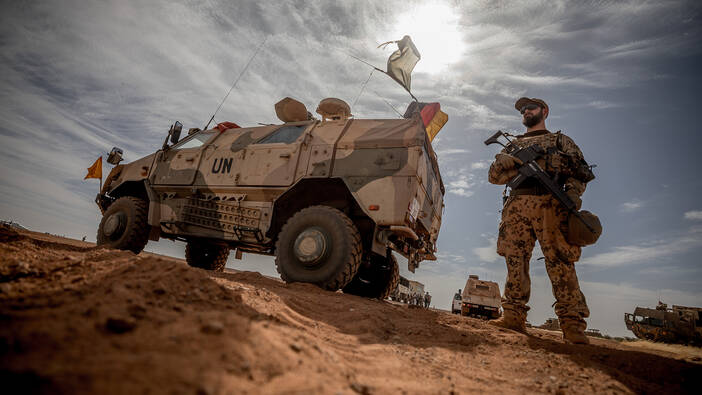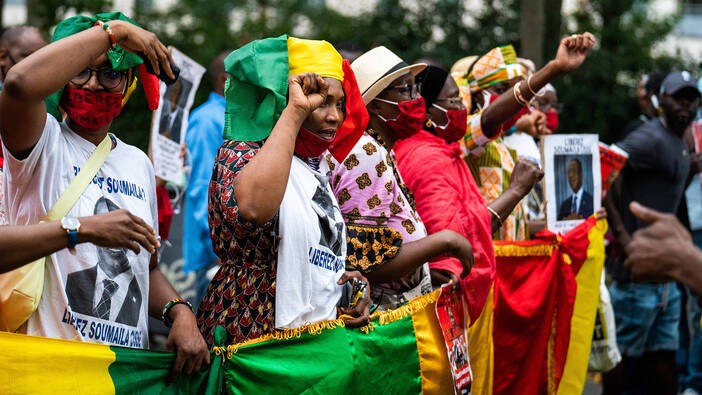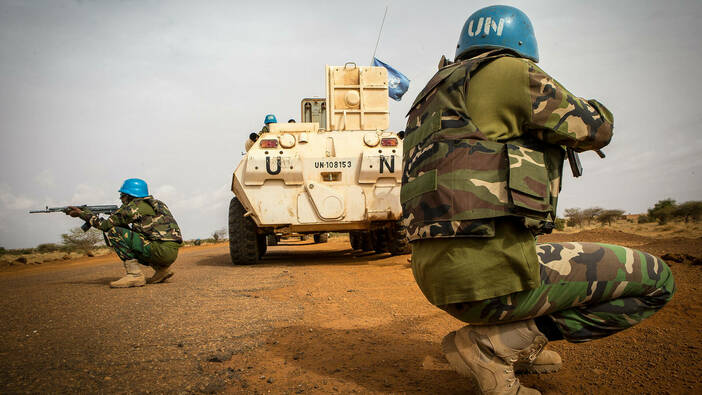![[Translate to en:] Jugendliche sitzen vor eine großen Landkarte aus Beton. Sie zeigt Mali und die Nachbarländer.](/fileadmin/_processed_/e/d/csm_landkarte-mali_8c49bbd4cf.jpg)
Mali’s political and security crises reinforce each other. There have been various ad hoc responses, either based solely on security or on a mixed approach—a combination of security and dialogue—though none have had lasting success. Yet, considering the internal upheavals and increasingly worrying threats in the Sahel-Sahara region (political Islamism and international jihadism), it is crucial that Mali, by its governors and social engineers, sets about containing the structural conflict.
Ibrahim Ag Idbaltanat is an expert in development and community dialogue, Soumaguel Oyahit is a social anthropological communicator, and Abdoulaye Macko is an expert in geopolitics and conflict management.
Translated by Sam Langer & Marty Hiatt for Gegensatz Translation Collective.
Despite the signing of the Bamako peace accords in June 2015, and the fact that international peacekeeping forces have been present in the country for almost eight years, the crisis in Mali is far from being resolved. The country is facing a multitude of challenges that require reliable, long-term solutions. The security crisis, which has shaken the country and which is marked by the presence of armed autonomous movements, jihadist insurgencies, and community self-defence groups, is really only the symptom of a crisis the goes right to the heart of the Mali nation.
Violent extremist groups are flourishing where the state either is contested, has no presence, or where it only manifests in the action, and often the abuses, of security forces. These spaces arise when inter-communal conflicts over access to natural resources intensify or when their peaceful management is no longer assured by a defective state or by traditional authorities that are now disputed. Here, radical groups are taking root by making themselves useful and supporting certain groups against others. They offer a kind of protection, weapons, and military know-how, and are also a response, however temporary, to a strong local demand for justice and security. The centre of Mali is particularly fertile ground for the implementation of their strategy of insinuating themselves. Violent extremist groups go after the state institutions; they chase away prominent local leaders as well as religious leaders who don’t share their point of view. Then they gradually replace them over large swathes of the territory.
The state is contested but not refused, including by some sympathizers of extremist groups. Yet by intervening in the centre of the country, state actors and their partners must not choose the wrong goals. The challenge is to restore the state’s credibility by just and effective action as close as possible to the population, whatever side people may say they are on. For the Malians are at the core.
The present analysis first looks at the centre of Mali. Stabilizing this highly populated zone, which also contains much of the country’s economic activity, is urgent. That is why we focus on the main actors in the crisis in this part of the country, namely the jihadists and the Dozo, the West African brotherhood of hunters. Then we look at the impact of different attempts at intra- and inter-community dialogues followed by some considerations on negotiations with the Jihadists.
Who are Mali’s Jihadists?
Jihadism initially gained ground in the north of the country following Algeria’s destruction of the Groupe Islamique du Salut (GIA). Its first leaders were either Algerian, Mauritanian, or Sahrawi. From 2012 onwards, people from the Touareg, Arab, and Fula communities were recruited in Mali. By now people from almost all of Mali’s ethnic groups can be found among the jihadists. Yet it is in the south the recruitment is focused on the Fula communities, while in the north it focuses on Touareg and Arab communities. The Fula are the second most populous ethnic group in Mali and are present in almost the entire country, from Kayes to Ménaka, including Gao, Timbuktu, Mopti, Ségou, Koulikoro, and Sikasso. Yet thanks to their many movements, most Fula no longer speak their own language. This is the case of the Fula in Wassoulou and in Sikasso, and of the Khassonké in Kayes. In losing their own language, they have also lost other aspects of their culture, such as animal rearing. Meanwhile, the Fula in the centre and the north have preserved their animal rearing traditions and their warrior spirit. Predominantly Muslim, they see themselves in the tradition of the theocratic kingdom under Seku Amadu in the nineteenth century.
In the past as in the present, we are witnessing Fula shepherds coming into permanent conflict with Bambara farmers in the saturated regions of Mopti and Ségou, with Dogo farmers in the emerging part of the Mopti region (around Bandiagara, Bankass, Koro, and Douentza), and with Songhai farmers in the regions of Timbuktu and Gao. In the region of Ménaka, the country’s premier livestock farming area, we occasionally see fierce confrontations between Touareg and Fula shepherds, including theft of animals.
In the centre of Mali, people often focus on the shepherds, forgetting those who constitute the real epicentre of the conflict: the talibés, students studying the Quran. Fula shepherds have a lot to lose, which is not the case for tens of thousands of students and their young teachers, the marabouts, who have little education and few prospects. It is the latter who responded to the call of Fula preacher Amadou Kouffa. They have taken up arms for various reasons: for jihad, revenge, and simply for protection. These students, fanatic Muslims, have been hardened by the tough treatment meted out to them by their no less fanatic marabouts.
Thousands of these young people find themselves with no future prospects, no qualifications and no opportunities. So they are easy prey for avid jihadis, who recruited them en masse as mujahideen or fighters for the way of Islam. Familiar with the territory, in revolt and inclined to vengeance toward a society that has no place for them, they continue to constitute a serious danger for the state and the communities. The present period is very favourable to these talibés to take revenge on their rich shepherds who once mocked them for their poverty.
What the Dozo Represent
The Dozo, a brotherhood of hunters, are found in the centre with both the Bambara as with the Dogon. In the past they served as fighters in kingdoms and lands that were established prior to colonization. They are generally healers and possess mystical powers, but they are farmers and hunters, too. As hunting is disappearing with the loss of wildlife, the activities of the Dozo, known as dozéa, have increasingly become cultural (presiding over marriage ceremonies, and various festivals).
Following numerous acts of retribution perpetrated by bandits and jihadists, the Dozo have taken up a new challenge: that of defending their villages against attackers. Among the Dogon, Dozo self-defence groups are known as Da Na Ambassagou (the hunters who trust in God). The Dozo movement has been observed in the Sikasso region, toward the centre, helping out their brothers. Furthermore, there are experienced Dozo who played a significant role in the occupation of the north of neighbouring Ivory Coast from 2000 to 2010, and who hence played a role in the not yet solved conflict there.
Dialogue, or Small Steps towards Peace
Malian civil society organizations, supported by the United Nations Multidimensional Integrated Stabilization Mission in Mali (MINUSMA), the Swiss NGO Humanitarian Dialogue, and many other partners, have been working tirelessly for the return of peace in the centre of Mali.
From 2019 until today, there have been more than twenty different dialogues organized in the centre, mainly in the counties Koro, Bankass, Douentza, Djenné, and in the Office du Niger. The area is characterized by direct confrontations between the Dozo and jihadists. The victims are mainly from the civil population on both sides. In addition to the massacres and reprisals between Fula and Dogon, or between Fula and Bambara, there has been considerable movement of people trying to escape, followed by a complete stalling of economic activities. Often there is no town market, no farming, and no livestock rearing.
From a HD report: “In 2019, the neighbouring municipalities of Baye and Ouenkoro had already committed to peace, which resulted in the pause in attacks between communities, the return of 400 displaced people, as well as the lifting of nine embargoes. However, inter-community mistrust in the rest of the circle had prevented the expansion of mediation efforts. The level of violence continued to escalate, culminating in the attack on the Ogossagou village on 23 March 2019, resulting in the deaths of over 160 Fulani civilians.”
In January 2021, in the neighbouring county, an agreement was signed between members of the same communities living in different communes. There was a knock-on effect from one county to another, from one commune to another. The implicated actors, including the jihadists, follow this dynamic.
On 7 February 2021, a humanitarian peace agreement was signed between the Fula, Dafing, and Dogon communities from seven out of the twelve communes in the county of Bankass in central Mali. They committed to preserving the safety and free circulation of people, goods, and livestock, and condemned violence in Bankass.
In March 2021, a meeting gathered community leaders from the counties of Tidermène and Achiboghou along with representatives of the jihadists at Infalfalane. The topic was the collection of a local tithe. It was agreed that everything pertaining to Sharia, including the tithe, would be the responsibility of local religious leaders.
It should be noted that various such agreements have been made throughout the country. In other words: traditional mechanisms work to maintain social peace. As stated in a report by HD, The protocols of the agreements are generally similar. They pursue:
- Encouraging community leaders to commit to peace by pardoning all past actions and by dissemination messages of peace and cohesion;
- Facilitating the free circulation of people and of their goods across all the communes;
- Accompanying and facilitating the return of all displaced people;
- Encouraging and facilitating the frequenting of the villages and markets by all the communities;
- Avoiding the circulation of weapons in the villages and towns;
- Opposing theft of livestock and facilitating the search for stolen animals and goods so that they can be restored to their owners;
- Facilitating the use of natural resources and land by all communities;
- Supporting the socio-economic development of the communes by encouraging the gradual return of basic social services and the access of NGOs to the area;
- Respecting the laws, customs, and places of worship of the different communities;
- Respecting the moral authority of traditional and religious authorities, who, before the crisis, ensured social cohesion and eased social tensions.
In 2021, agreements were made in the counties of Douentza and Djenné. The most recent agreement was made on 14 March 2021, at Niono, between jihadists and the Dozo, under the supervision of the Islamic High Council of Mali. It is the only agreement whose validity is limited to one month. The jihadists’ demand that the Malian army pull out of the village of Farabougou seems unacceptable to the general public. Yet this still amounts to many small steps toward peace, which must not be rejected. The Fula and Bambara populations who are relishing these times of peace will no doubt hold to the agreements.
Negotiating with Jihadists: A Chance for the Malian State?
Although it may seem strange, some observers think that the jihadists have played an important role in maintaining unity in Mali. In April 2012, when the secessionist Touareg movement the Azawad National Liberation Movement (MNLA) proclaimed Azawad’s independence, it was chased out of the north by jihadists from the Movement for Unity and Jihad in West Africa (MUJWA), and from the movement led by Iyad Ag Ghali, Ansar Dine.
A sober reflection is necessary. Of course, violent extremism is not a solution. Yet the Malian jihadists do not have radical political demands, they see themselves as defenders of social justice which they aim to achieve through the official application of Sharia law. It has been shown that the jihadists are available for negotiations whenever they are needed: for the release of hostages, opening of schools, reopening of weekly markets, etc.
The different local agreements made between civil society organizations and the jihadists in the north as well as the south of the country have doubtlessly contributed to a reduction in the suffering of the civil population, although in a temporary manner. They are small steps on a path to peace that need to be reinforced and multiplied, not the least due to the fact that all of the forums organized by the state for national reconciliation, particularly including the sittings of national dialogue, have all called for entering into dialogue with the Malian jihadists.
It will take less effort and energy to create a lasting peace with the Malian jihadists than with the rebels in the north. The former want a system of governance based on Sharia law, while the latter have political demands such as political power and autonomy.
Prospects for Dialogue with the Jihadists
We need to enter into dialogue with the jihadists, particularly their leaders Iyad Ag Aghali and Amadou Kouffa. We know their demands, which for the most part are juridical and are already lived on a daily basis. We should recall that:
- Since independence, in most towns in the north, the majority of social disputes have been managed by Qadis (Islamic magistrates), so Sharia is already being applied.
- Religious marriage is recognized by a marriage certificate just as civil marriage is.
- For Muslims, inheritance is largely governed by Islamic law. A civil judge will only intervene when asked to do so by one of the beneficiaries.
- Regarding the teaching of the Quran, the city of Timbuktu offers the best example, thanks to the following compromise reached between the city’s Muslim communities and French colonists, when the latter demanded that all residents send their children to French schools: their children go to Quran school early in the morning and late in the afternoon, while they attend French school inbetween. This ensured they could be taught in both schools. That way, Timbuktu offers one of Mali’s best examples of secularism and religious tolerance. However, we need to change our language in order to change people’s mentalities. In most of our vernaculars, the term for French school is school of the infidels (“Takafart en Tamasheq”, or also “language of Toubabou”, this latter term being extremely pejorative in our languages).
At the same time, it remains the duty of state actors and their partners to observe the principle of proportionality when using force. Especially in the centre, the traps of the jihadists must be avoided. For by mingling with the population, they knowingly encourage collateral victims in interventions by the Malian army and its partners. It is obvious that this is condemned by human rights organizations.
To conclude, a sincere and frank dialogue with the jihadists will lead to a more fruitful compromise than the one we are currently living through. The application of Mali’s Algiers Peace Agreement constitutes a significant lever to ensure this dialogue ends well.
The views expressed in this text are those of the authors and do not necessarily reflect the politics and official positions of the Rosa-Luxemburg-Stiftung.


